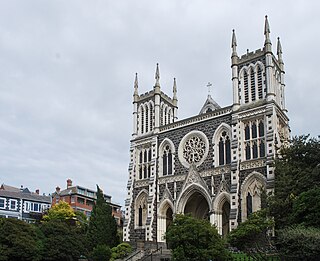
The University of Otago is a public research collegiate university based in Dunedin, Otago, New Zealand. Founded in 1869, Otago is New Zealand's oldest university and one of the oldest universities in Oceania.

Dunedin is the second-largest city in the South Island of New Zealand, and the principal city of the Otago region. Its name comes from Dùn Èideann, the Scottish Gaelic name for Edinburgh, the capital of Scotland. The city has a rich Māori, Scottish, and Chinese heritage.

David Henry Benson-Pope is a New Zealand politician. He is a former Member of Parliament for Dunedin South and has been a member of the Dunedin City Council since 2013.

Dunedin railway station is a prominent landmark and tourist site in Dunedin, a city in the South Island of New Zealand. It is speculated by locals to be the most photographed building in the country, as well as the second most photographed in the southern hemisphere, after the Sydney Opera House.

Thomas Morland Hocken was a New Zealand collector, bibliographer and researcher.

Princes Street is a major street in Dunedin, the second largest city in the South Island of New Zealand. It runs south-southwest for two kilometres from The Octagon in the city centre to the Oval sports ground, close to the city's Southern Cemetery. North of The Octagon, George Street continues the line of Princes Street north-northeast for two and a half kilometres. Princes Street is straight but undulating, skirting the edge of the City Rise to its northwest. The part of the street immediately below The Octagon is the steepest section, as the road traverses an old cutting through Bell Hill.

Moutoa Gardens, also known as Pākaitore, is a park in the city of Whanganui, New Zealand. Named after the Battle of Moutoa Island in the Second Taranaki War, it contains a memorial to the battle inscribed "To the memory of the brave men who fell at Moutoa, 14 May 1864, in defence of law and order against fanaticism and barbarism." It also contained a statue of John Ballance, organiser of a volunteer cavalry troop in Tītokowaru's War and later Premier of New Zealand, but the statue was beheaded and a replacement installed outside the district council building. A number of items present in the park are registered by Heritage New Zealand.

St Joseph's Cathedral is the cathedral for the Roman Catholic Diocese of Dunedin. It is located in City Rise in the city of Dunedin, New Zealand. It serves as the seat of the bishop of the Latin Church Diocese of Dunedin, which was erected on 26 November 1869.

Dunedin Hospital is the main public hospital in Dunedin, New Zealand. It serves as the major base hospital for the Otago and Southland regions with a potential catchment radius of roughly 300 kilometres, and a population catchment of around 330,000.

Thomas Burns was a prominent Scottish early European settler and religious leader of the province of Otago in New Zealand.

Dunedin Chinese Garden is a Chinese garden located in Dunedin, New Zealand.
The Star is a free newspaper published weekly in Dunedin, New Zealand by Allied Press since 1979. It is the successor to The Evening Star, which was the city's daily evening newspaper from June 1863 to 1979.

The fourth plinth is the northwest plinth in Trafalgar Square in central London. It was originally intended to hold an equestrian statue of William IV, but remained empty due to lack of funds. For over 150 years, its use was debated; in 1998, the Royal Society for the encouragement of Arts, Manufactures and Commerce (RSA) commissioned three contemporary sculptures to be displayed temporarily on the plinth. Shortly afterwards, Chris Smith, Secretary of State for Culture, Media and Sport, commissioned Sir John Mortimer to seek opinions from public art commissioners, critics and members of the public as to its future. Mortimer's final report recommended that there continue to be a rolling programme of commissioned temporary artworks rather than settle permanently on one figure or idea.

The Statue of Robert Falcon Scott, commonly known as the Scott Statue, is a statue in Christchurch, New Zealand commemorating British Antarctic explorer Robert Falcon Scott. The statue was unveiled in 1917 and is located at a small recreational park at the intersection of Worcester Street and Oxford Terrace in Christchurch Central City. Scott likely died on 29 March 1912 during his Terra Nova Expedition to the South Pole. His death became public knowledge on 10 February 1913, in response, locals organised a committee dedicated to Scott within one week of the news of his death. The statue was commissioned to be carved by Scott's widow, Kathleen Scott, in which she travelled to a marble quarry in Carrara, Italy to carve it in March 1916. Her work was shipped to New Zealand in late 1916 and was unveiled on 9 February 1917. The statue is one of few monuments recognising the significance of early 20th-century Antarctic exploration.

Donald McNaughton Stuart was a New Zealand Presbyterian minister and educationalist.

Queens Gardens is a roughly triangular area of trees and lawn in central Dunedin, New Zealand.

Rachel Jane Brooking is a New Zealand Labour Party politician and Member of Parliament who served as the Minister for Oceans and Fisheries and Minister for Food Safety in the Sixth Labour Government. She first became an MP at the 2020 New Zealand general election. She is a lawyer by profession.

The Gladstone Memorial on the Strand, London is a bronze sculpture of the British statesman, created by Hamo Thornycroft between 1899-1905. The statue was erected as the national memorial to Gladstone and shows him in the robes of the Chancellor of the Exchequer. The figure stands on a plinth surrounded by allegorical figures depicting four of the Virtues, Courage, Brotherhood, Education and Aspiration. The memorial is a Grade II listed structure.

Jules Vincent Radich is a New Zealand politician who has served as the 59th mayor of Dunedin, New Zealand since 2022. He has also served as councillor for the Dunedin City Council since 2019. Radich also serves as deputy Chair of Infrastructure and sits as a member on the Saddle Hill Community Board.

Wellington's Queen Victoria Monument is an early 20th-century statue of Queen Victoria by British sculptor Alfred Drury. Copied after Drury's earlier 1903 Portsmouth statue, Victoria is depicted standing triumphantly in her Robe of State and widow's cap, holding a royal scepter and orb. The monument's plinth additionally features a plaque and three bronze reliefs, designed in the New Sculpture style, depicting the Treaty of Waitangi and various artistic and scientific inventions of the Victorian era.























